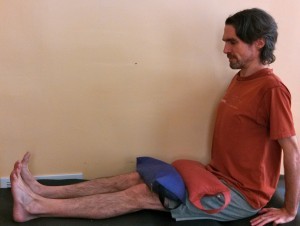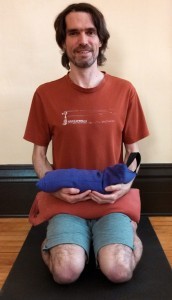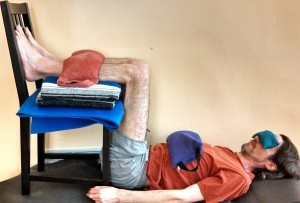Would you like to find a practice that doesn’t take long but has big effects?
If so, I can imagine some reasons you might be interested might be interested. It could be that…
a) you’re looking for an effective way to develop strength and flexibility.
Or perhaps you…
b) need to focus.
Then again, maybe you are desperately seeking…
c) something to calm down a stress-filled life.
Or could it be…
d) all of the above?
It just so happens that weights can help with all of the above.
To be clear, I don’t mean lifting them. There are many ways weights can support well-being besides being lifted. Also, objects other than a standard barbell plate can usefully serve. Sand bags, ankle weights, and bags of rice or beans come immediately to mind.
What’s more, weights are versatile in their effects: they can support strength and mobility, provide focus, and help to calm a highly strung nervous system. The latter two qualities are useful in seated meditation, but also serve a purpose in asana practice, whether active or restorative.
Asanas with Weights
The sequence below includes dandasana (staff pose), virasana (hero’s pose) and chair savasana (corpse pose). Adding weights to each of these asanas has the effect of amplifying a particular quality.
In this case, dandasana with weights emphasizes strength and mobility, virasana supports focus and savasana accentuates calm. At the same time you could certainly do one of these poses and find more than the primary attribute. For instance, using the weights in dandasana can facilitate an experience of calm and heightened focus in addition to promoting strength and flexibility.
I encourage you to explore what strikes your curiosity. Any one or all of these could become a staple of your practice. At the same time, these three poses are a small sample of what you can do with weights. Use your curiosity and creativity to jump off from these to other possibilities.
With any of the following asanas, if you experience strain or pain that doesn’t feel right, that you can’t figure out, please consult a qualified teacher.
Dandasana

Weights on the front-thighs encourage the legs to lengthen and broaden into the floor. The anchoring of the legs can help people become more effective in lengthening the trunk away from the floor.
If your hamstrings are very tight, you may need to elevate your sitting bones on a blanket or lean your trunk a bit back away from vertical, placing your shoulders behind your hips to encourage space in your back. Whether your spine is vertical or leaning at an angle, encourage your trunk to lengthen through all sides.
Using weights in dandasana helps to clarify the folding of the hip joints in relation to the legs. This increases deep, centered strength and flexibility.
The weights encourage the muscles that hinge the hips to work with more precision and effectiveness. In turn, this increases flexibility in the hamstrings and the hip joints.
Virasana with weight
Please note that if your knees can’t tolerate being in virasana, you can do the same practice sitting in a chair.

Sit in virasana with your inner knees close together and your inner ankles wide, lengthening back through your big toes. Place a block under your sitting bones so that your knees are not strained.
The purpose of the weight is not to push oneself lower into the pose. Instead it serves as a focus of attention.
If you have one weight, you can rest it on your legs, or you can cradle it in your arms (like a sleeping baby or a pet).
Let the sensation of the weight become an anchor for your attention. Let your attention be with the weight. Your attention will shift to other things, but you can keep it coming back to the weight.
If you are a person who has difficulty sitting or doing meditative practices because of a wandering mind, you may find that the weight provides a helpful focus because the sensation is concrete. Also, many people find that the feeling of weight causes thoughts to slow down and settle.
Chair Savasana

In chair savasana we take the settling capacity of weights further into an interior and restorative state. If you have an eye pillow, using it will further emphasize the deep repose that is offered, and it will allow you to bring your attention more fully to the sensation of the weight.
In this variation of savasana, the calves rest on a chair with the knees directly over the hips. Both the knee and hip joints are therefore at a right angle. Some people will be more comfortable having a slight elevation under the pelvis. A blanket may be used for this.
Depending on the height of the chair, you may need to place blankets or a bolster on the chair-seat to bring the lower legs to the proper level. Weight can rest on the belly and/or lower ribs, and can also be draped across the shins.
As in virasana, the sensation of weight can serve as a focus for attention. You can also let your attention be with the broad surfaces of your back body, allowing them to fully meet the floor (of course, the weight will help this).
Weight resting down into the body will emphasize a lengthening of the exhalation phase of the breath. People who tend to have short exhalations, may discover that this feels unfamiliar, disconcerting, even uncomfortable.
If this is the case, start with less weight as you learn to accommodate to new sensations. Even if it feels uncomfortable at first, it’s worth the time because ultimately this practice lets the breath, the body and the mind settle in a deep and wonderful way.
Again, while these poses work well together, they may also be done separately. Or the asanas described here can serve as a spark for other explorations.
May this inspire your practice!


